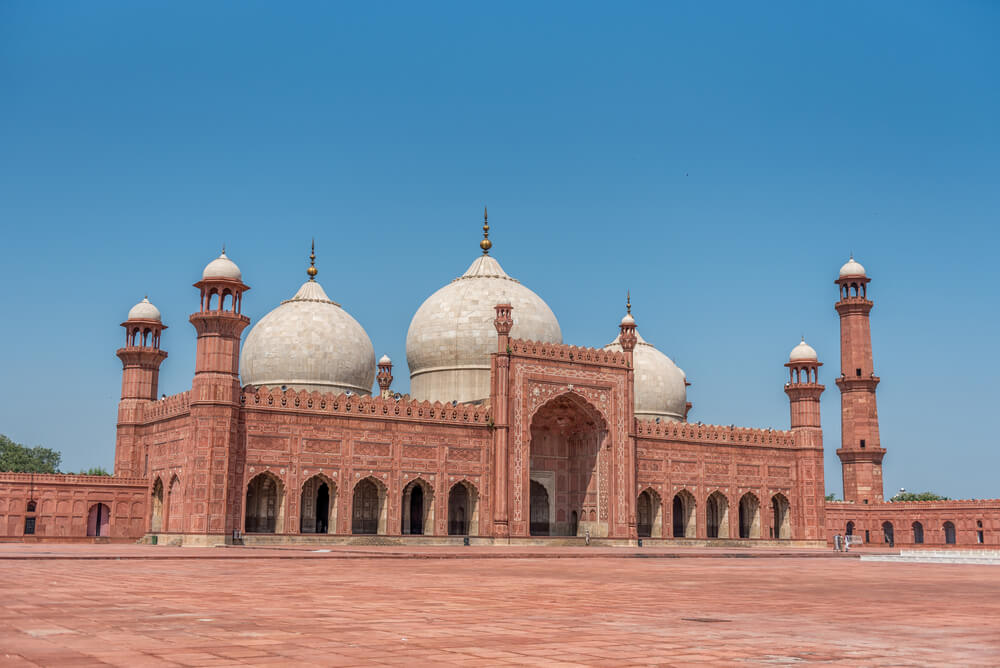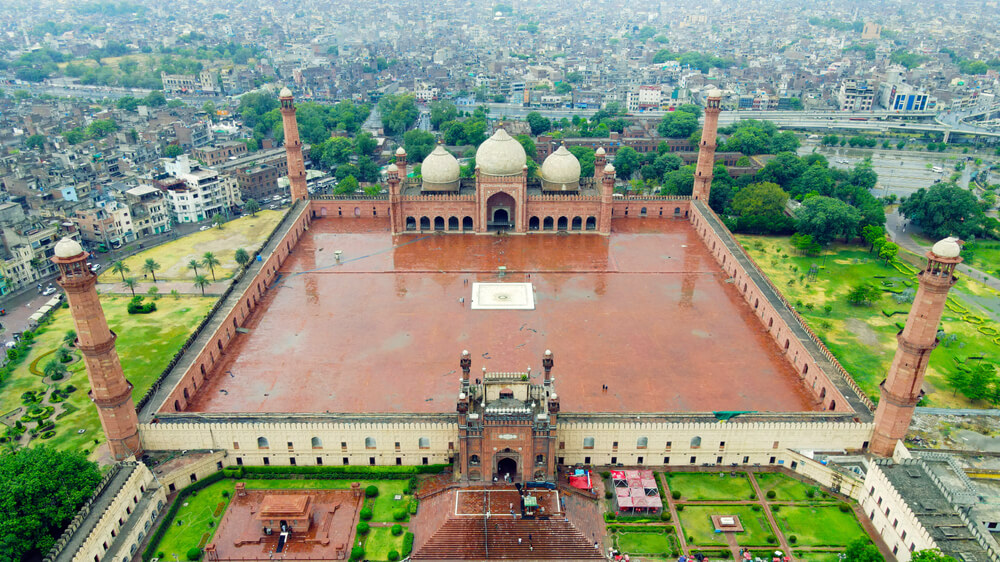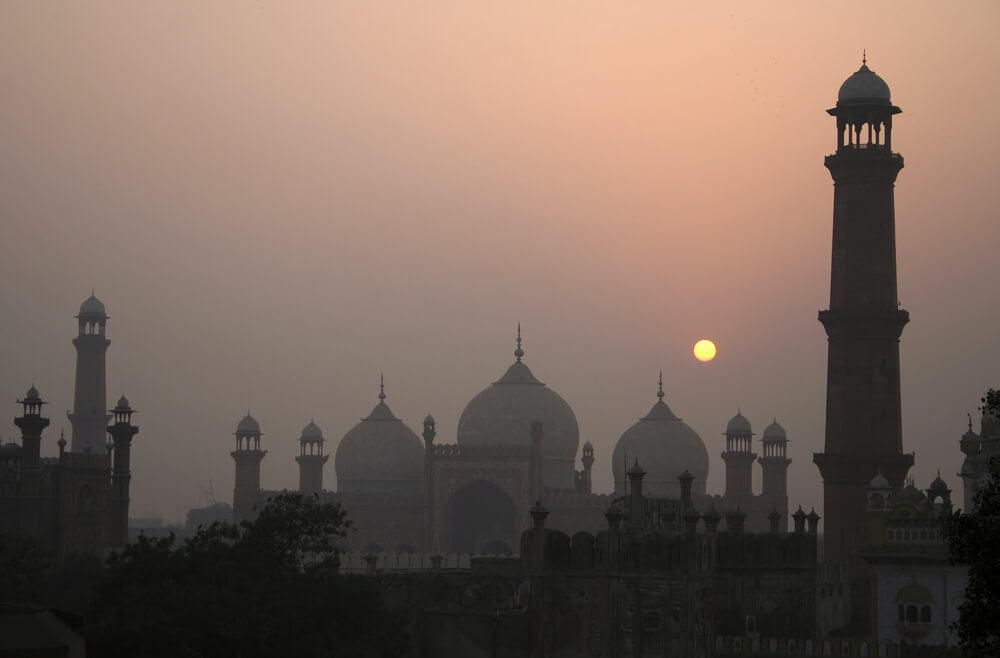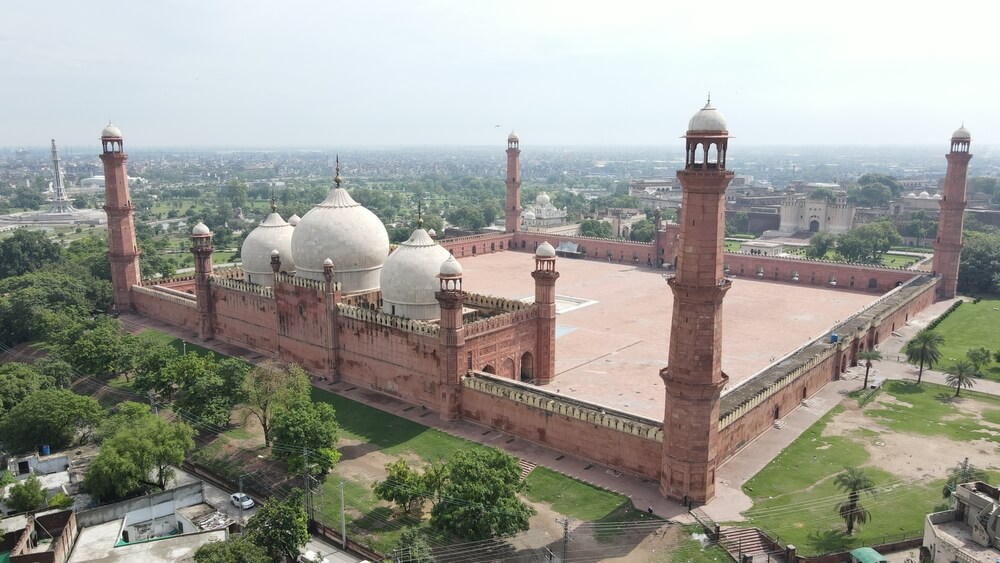Badshahi Mosque Lahore
Badshahi Mosque is an architectural landmark of Mughal times situated in Lahore, Pakistan. The Mosque was initially made over four centuries ago by one of the most famous Mughal emperors, Aurengzeb. The date of construction is believed to be around 1671 and 1673. After its completion, the Badshahi Masjid Lahore remained the title of the world’s most splendid Mosque for thirteen years. This tremendous architectural accomplishment remains the standing proof of great Mughal architecture and the prominence of workers in this respective field.
History of the Badshahi Mosque
The noticeable quality of the Mosque in the royal vision was to achieve such an extent as to enable the Mosque to be developed only a couple hundred meters toward the west of Lahore Fort. An extraordinary door confronting the Mosque was added to the post and assigned the Alamgiri entryway. The middle between- – the future Hazuri Bagh garden- – was utilized as a parading ground where Aurangzeb would survey or watch the marching of his soldiers and subjects. The Hazuri Bagh gives off an impression of being at a lower level than the Mosque since the last option was based on a six-meter podium to provide additional assistance with forestalling floods.
The Mughal Emperor Aurangzeb fabricated the Badshahi Mosque, which in the national language of Pakistan that is; Urdu, may be understood as the Emperor’s or King’s Mosque, in 1673 in Lahore, Pakistan. The title bequeathed to the monument is the mark of the Monarch (Aurangzeb), which carries with it the sovereign legacy and the related history, both of the Era which surrounded it and paid homage to it, the Royal family which oversaw its construction and marked its purpose.
The Mosque shows an incredible illustration of Mughal period design. The haven is the second biggest Mosque in Pakistan, after the Faisal Mosque in Islamabad, which obliges more than 55,000 admirers. Jama Masjid in Delhi, India, intently looks like the engineering and plan of the Badshahi Masjid. Badshahi Masjid is one of the places where Qari Abdul Basit presented the Qur’an.

The size of Badshahi Mosque is challenging to comprehend. It may have been the largest building in the world during the seventeenth century. Fifty-five thousand worshipers could gather together for prayers in the Mosque. That is the equivalent of many sports stadiums. The Mosque was built on and upheld Islam like Hagia Sophia in Constantinople during the sixth to fifteenth centuries and upheld Eastern conventional Christianity.
Worked under the support of the 6th Mughal Emperor, Aurangzeb Alamgir, the Mosque ended in 1673. Aurangzeb’s close sibling Muzaffar Hussain (otherwise called Fidaie Khan Koka), the legislative head of Lahore from 1671 to 1675, managed the structure. He likewise filled in as Master of Ordnance to the ruler. The development of the Mosque required a long time, considerably from May 1671 to April 1673. Worked inverse the Lahore Fort, a place that outlined its significance in the Mughal Empire, Badshahi Mosque assumed a regarded position in the realm. Related to the structure of Badshahi, the Emperor had another entryway worked at the stronghold named Alamgiri Gate.
Badshahi Mosque had gravely harmed and abused during Sikh Rule. When the Sikhs administered Lahore, they involved the Mosque for horse pens for the many ponies, camels, and creatures they utilized. They would also take the gems from the Mosque, like marble, rubies, gold, and other resources. Sikhs restricted Muslims from entering the Mosque to venerate, the public authority conceding just a little spot outside the Mosque where they could pray.
When the British assumed command over India, they involved the Mosque for military preparation, including rifle and gun shooting range. Detecting Muslim disdain for them, the British wrecked a considerable part of the Mosque’s mass, rendering it unusable as a revitalizing spot because of hostile British usage. The British later returned the Mosque to Muslims as a kindness motion, even though the design had been severely abused from abuse and disregard. The Badshahi Mosque Authority reestablished the sacred spot to its unique greatness.
The Badshahi Mosque Authority administered just piecemeal fixes starting in 1852. The authority completed broad holes from 1939 to 1960, costing 4.8 million rupees. Those fixes took the Mosque back to its unique shape and condition. The draftsman Nawab Zen Yar Jang Bahadur arranged the diagram for the holes. On the event of the second Islamic Summit held at Lahore on February 22, 1974, 39 heads of Muslim states offered their Friday petitions in the Badshahi Masjid, drove by Maulana Abdul Qadir Azad, the ‘Khatib’ of the Mosque. In 2000, Saleem Anjum Qureshi regulated the maintenance work of marble trim in the virtual vault. As of late, a little exhibition hall containing relics of Muhammad, his cousin Hazrat Ali Razi Allah Anho, and his girl, Hazrat Fatima ZahraHazi Allah anha, has been added to the mosque complex.
The Badshahi Mosque in Lahore, finished in 1673, had been planned and built as a commendation to Lahore Fort. Lahore Fort had been remade north of a century sooner, in 1566, by Mughal head Akbar. The imagery of building the tastefully satisfying Badshahi Mosque opposite the considerable Lahore Fort gave the joined impression of magnificence and elegance with strength and power. That mix catches the significance of Mughal engineering. The Mughals were acquainted with Indian design that has come to represent the excellence and persona of Indian progress. Since Pakistan split from India in 1947, Pakistan has elevated the Badshahi Mosque and Fort Lahore as images of the country.
Interesting Facts about Badshahi Mosque
The situation of the Mosque deteriorated, that is, when it was left in unfit hands under the rule of Ranjit Singh, the Maharaja of the Sikh Empire. At the point when Ranjit Singh assumed command over Lahore in 1799, the Mosque’s yard was utilized as a stable for horses and chattel, and the chambers around the border were given over to the ruler’s warriors, foot-soldiers, etc., who did not care as much for it as did the prime ruler. Ranjit Singh turned to utilities of the neighboring Hazuri Bagh and used it as his imperial authority court. When William Moorcroft of England visited Lahore in 1820, he made several notes of the circumstances he witnessed therein and concluded that the Mosque had somewhat become an activity ground for the Sipahi infantry. After twenty years, a moderate seismic tremor struck Lahore and imploded the sensitive marble turrets at the highest points of the Mosque’s several minarets.
Subsequent years
After they assumed British command over Lahore in 1846, they kept the status of the Badshahi Masjid Lahore as a tactical, that is to say, tactical military post. Although in 1982, the British authorities residing in the Mosque relinquished that authority deliberately on amicable grounds, thereby rendering the official use and ownership of Lahore’s Badshahi mosque over to the Muslims.

Starting from 1939, it took the contemporary ruler and his workers an additional twenty-one years to properly remedy the fixes in the Mosque.
Size and Architecture of Badshahi Mosque
The most prominent feature of Lahore’s Badshahi mosque, which still retains the remarkable third position of the most significant mosques in Pakistan, is its vast accommodation limit. The main yard, which presents itself over the enormous scale of 276,000 square feet, can accommodate over a hundred thousand people at a time.
The architectural aspects of this vast landmark are one of the many attractions for foreigners and locals. The walls are collaboratively decorated with inlays and carved symbolism of Mughal art, giving the space an eerie vibe of its former prime glory. In contrast with the outer yard, the prayer hall was meant as a worshipping space. The prayer hall has its vast and impressive limit of affording over ten thousand people the freedom to worship simultaneously.
The minarets allow their aesthetic glory in the presence of all the surrounding majesty of the Mosque. The minarets are over 190 feet tall, presenting the viewer with a beautiful looming masterpiece of human architecture that has stood the many tests of time.
Attractions Offered By Badshahi Mosque for Tourists?
Tourists worldwide crave the sights offered by the majestical and prominent architecture of Lahore’s Badshahi mosque. Each aspect of the great site appeals to different people who have a keen eye for an artistic architect, especially concerning antiquity. The beautiful prowess of the Badshahi masjid Lahore has been thoroughly commended by classical and contemporary professional architects and artists. This widespread fame, riddled with accounts of former travelers, induces a passionate want in amateur travelers from all over the world to see the landmark for themselves.
The Badshahi Mosque is also an extraordinary tourist attraction because of the relics it contains. A portion of those relics is considered to belong to the early founders of Islam, which is the common religion of the people. People of the same faith travel to the Mosque to interact or to see these relics with their own eyes and consider the pilgrimage a great honor. Some of the other dinosaurs are said to have once had a place with direct relations with the prophet, including his daughter and her husband. These relics generally contain clothes worn by the people hitherto mentioned, tools for their daily uses, other belongings, etc.
As Intriguing enough, Lahore’s Badshahi Mosque, unlike most different mosques made during the period, bears distinctive engravings.
One is situated at the main entry and peruses: “The mosque of Abu Zafar Mohiuddin Muhammad Alamgir, the Ghazi King, finished under the administration of the humblest worker of the family, Fidai Khan Koka, in 1084 AH.”

Like the more significant part of the remainder of the design, the outside walls of Lahore’s Bashahi Mosque are staggeringly itemized and complicatedly beautified. Molded boards make up the walls.
What’s more, at the edge of each wall stands a pinnacle total with a turret and vault. The turrets are sandstone, and the lockers are made of costly white marble.
The unique beauty of the Badshadi Masjid Lahore still keeps distinctive aspects that no other architectural landmark appropriately contends with. from the great hall to its beautiful minarets, and each fragment represents its subjective beauty, which makes it a distinctive tourist attraction.
With an end goal to reflect the personality of its pioneer, planners planned the Mosque to ooze intensity, tremendousness, and magnificence. The Mosque had been biggest on the planet at the hour of its structure. The inside has decadent frivolity in plaster lattice (Manbatkari) and framing with a fresco contact, all in solid help and marble trim. Stone cutting and marble trim on red sandstone, uncommonly of loti structure themes in striking alleviation, adorns the outside. Embellishments on the Mosque show Indo-Greek, Central Asian, and Indian building impacts on procedure and articles.
Design of the Mosque
Wonderful decorative merlons, trimmed with marble lining, add beauty to the edge of the Mosque and embellish the horizon. In different compositional elements, like the considerable square yard, the side paths (dollars), the four corner minarets, the extending focal transept of the request chamber, and the excellent entry door, the historical backdrop of advancement of mosque engineering of the Muslim world over the thousand years preceding its development in 1673 finishes.
The north nook mass of the Mosque had been laid near the Ravi River bank, keeping the structure from getting a great passage on that side. To guarantee the door’s balance, no glorious entryway could also be based on the south side. In this manner, a four Taiwan plan must be deserted, similar to the previous Delhi Jamia Masjid. The walls had been worked with little oven-consumed blocks laid in kankar, lime mortar (a sort of water-powered lime), yet have a facade of red sandstone. The means prompting the request chamber and its plinth have been built with variegated marble.

The request chamber, incredibly profound, separated into seven compartments by rich engraved curves and continued hugely weighty wharves. Out of the seven compartments, three twofold vaults completed in marble have the creatively brilliant ebb and flow. In contrast, the rest have curvilinear arches with a focal rib inside and a level rooftop above. In the eastern front walkway, the compartment’s roof runs level (Qalamdani) with a bent line (ghalatan) at the molding level.
The first floor of the yard had been laid with little oven-consumed blocks set in the Mussalah design. The current red sandstone flooring had been laid during the last broad fixes from 1939 to 1960). Additionally, the first floor of the request chamber had been built utilizing cut and dressed blocks with marble and Sang-I-Abri lining, shaping Mussalah. During the latest fixes, they had been supplanted by marble Mussalah.
Location, Timing & Ticket Price
The Mosque is located to the west of Lahore fort, and It is open seven days a week from 8 AM till 8 PM. The ticket price is 30 Rupees per head.
FAQ
Who made Badshahi Masjid in Lahore?
Mughal Emperor Aurengzeb made it.
Who is the owner of Badshahi Masjid?
The Mughal Emperor Aurangzeb Alamgir constructed it.
Why is Badshahi Mosque famous?
It is one of the largest Mosques in the world and holds historical significance.
How old is Badshahi Masjid?
It was built in1673, which makes it about 350 years old.
How can I enter Badshahi Masjid Lahore?
You can purchase a ticket and enter the Mosque during visiting hours.
Where is Badshahi Mosque located in Lahore?
It is located to the west of Lahore Fort.
How many towers of Badshahi Mosque Lahore?
There are a total of 8 minarets. 4 are more extensive, and the other four are smaller.
Who was the ruler of Badshai Mosque Lahore?
Aurangzeb was the ruler of the Mosque.
